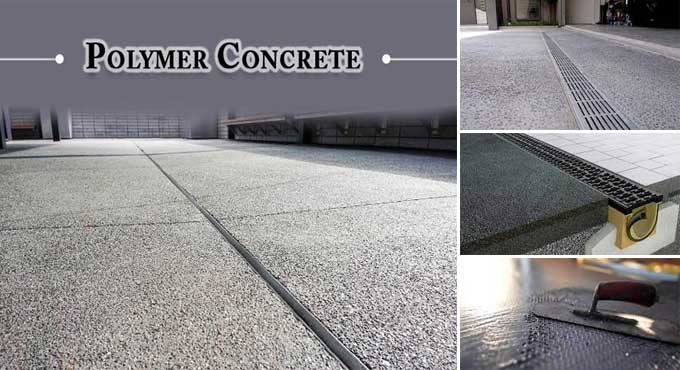
Polymer Cement Concrete (PCC): Properties, uses, advantages, and disadvantages
What do you mean by Polymer Concrete?
Polymer concrete is a composite material created by bonding aggregates in a matrix. Higher properties, less energy needs, and low labour costs are benefits of polymer concrete. Latex-modified concrete (LMC) or Polymer Portland Cement Concrete (PPCC) are further names for it.
Polymer concrete is made from OPC concrete that has been cured and impregnated with methyl methacrylate monomer, a liquid or vaporous chemical compound. The monomer is then polymerized chemically or by gamma radiation, or by using a thermal catalytic method in which 3% benzoyl peroxide is added to the monomer as a catalyst.
The impregnation is facilitated by absorbing the monomer under minimal pressure, and the concrete is cured at a high temperature utilising evacuations.
What is the composition of Polymer Concrete?
Portland cement is pre-polymerized (monomerized) with a dispersed polymer to create PCC. In-place polymers are formed during the curing process of the concrete. When using vinyl monomers, the hydration process can be interfered with or degraded. Therefore, prepolymers perform the function more effectively.
A higher concentration of these prepolymers can improve PCC's mechanical properties. When adding latex to this concrete feature, extra consideration is given since the polymer is the foundation. Using an emulsion improves the mixture's lubricating properties. As a result, a smaller amount of water is needed to work the mix.
What are the requirements of polymers used in PCC?
- The polymer network must intercept a growing micro rack. By dissipating energy through microfibrils, this is achieved.
- For the latex to fully cover the cement and aggregate particles, it must be able to create a film in ambient circumstances. This aids in strengthening the connection between the cement matrix and the aggregate.
What are the properties of Polymer Concrete?
1. Highly Durable
By using PCC, thick and watertight concrete is produced. This stops chemical assaults, water intrusion, and corrosion as a result. Moreover, interior microcracks in the cement matrix are avoided. This lengthens the structure's lifespan.
2. Highly Impermeable
It reduces the porosity of the cement matrix and microcracks that appear in it due to the polymer phase in the concrete. The Portland cement is used as a binding material in addition to this.
3. A Good Adhesive
In most cases, good adhesion to the old surface improves adhesion to the old surface.
4. Light in weight
Polymer concrete is lighter than concrete made from other materials.
Uses of Polymer Cement Concrete
1. Construction of Floors
It is the ideal option for industrial floor construction due to its improved chemical resistance capabilities and good physical and mechanical properties. They are furthermore utilised in pavement construction in heavily travelled areas.
2. Construction of Precast
Using PCC reduces the risk of reinforcement corrosion, spalling, microcracks, and corrosion of the reinforcement by providing a highly impermeable and watertight surface.
3. Bridge deck coverings
Using PCC will ensure a highly impermeable and water-tight surface, preventing moisture and chlorides from ingressing and resulting in reinforcement corrosion, spalling, and microcracks.
4. Can be used as Patching Compounds
Portland cement concrete can be patched and repaired with PCC. Existing structures become stronger and last longer as a result. The PCC must only be applied after the old material has been removed.
Polymer concrete: advantages and disadvantages
Advantages of Polymer Concrete
- In the event of freezing and thawing, polymer concrete is highly resistant.
- Carbonation and the subsequent loss of alkalinity in concrete are prevented by limiting the entry of carbon dioxide.
- The permeability level is very low.
- The material is highly compressible.
- Despite its high impact resistance, it is extremely lightweight.
- Cross-sections with extremely thin cross-sections can be made with it.
- Reduced shrinkage.
Disadvantages of Polymer Concrete
- The price of Polymer Concrete is very costly.
- The chemicals used to make polymer concrete can be hazardous to the skin, so masks and gloves should be worn.
- Not everyone can properly mix Polymer Concrete as it requires specialised skill and high levels of precision.
Factors to consider when using Polymer Cement in Construction
- Concrete mobile mixers must be used for mixing PCC.
- It should take less than 30 minutes to handle, place, finish, and finish PCC.
- After moist curing, PCC must be dried by air for one to two days.
- It is used for overlaying bridge decks, and floors, and patching concrete surfaces that range in thickness from 4 to 100 millimetres.
- Unless acrylic polymers are exposed to UV light, concrete will discolour when exposed.
- In cases where evaporation rates exceed 0.5 kg/m2/h, PMC has a tendency to shrinkage crack during placement.
- Axially loaded members must be evaluated according to their modulus of elasticity, which is generally lower than conventional concrete.
- For large applications of polymer-modified concrete, continuous mobile mixers equipped with latex storage tanks are necessary.
- In the case of small batches or mortar mixers, the mixing time is limited to three minutes.
- A temperature range of 7 to 30?C should be used for placing and curing PCC.
- When colour retention is important, acrylic latexes can be used for floor repairs and patching.
- Suitable for overlaying bridge decks, floors, and patching concrete surfaces ranging in thickness from 4 to 100 mm.
- Wearing surfaces produced by these overlays are very durable and resilient to weathering.
To get more details, watch the following video tutorial.
Video Source: Anime_Edu - Civil Engineering Videos


